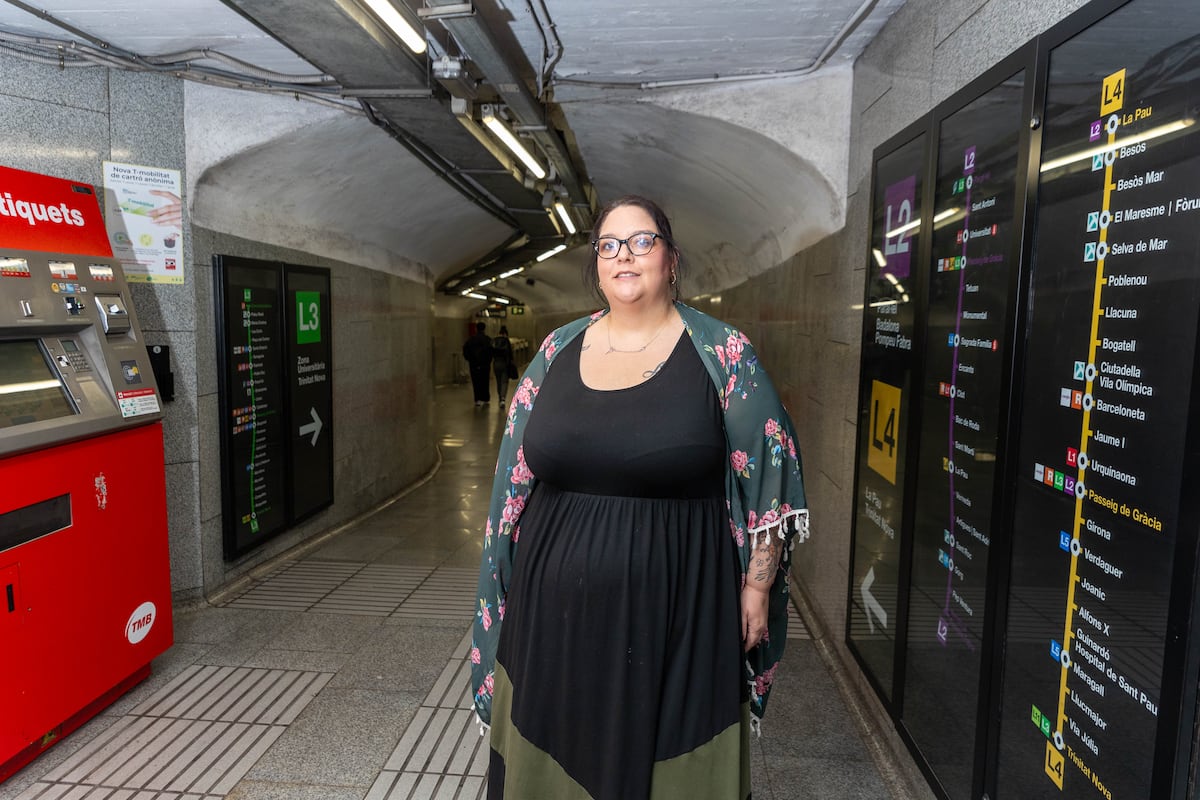Anna Gómez, a regular user of the Rodalies de Tarragona in Barcelona and affected by the cuts, poses at Barcelona’s Passeig de Gracia station.Kike Rincon
After the pandemic, Paola R. and her partner turned their lives around. They took their two children and slammed the door to the Gràcia neighborhood of Barcelona to go live in Castell de Montornès (Tarragonès). They were looking for a better environment, but also to escape the endless increases in rental apartment prices in Barcelona. In exchange, you had to pay a toll: from being seven minutes from work to an hour and a half away with the train, but since this psychologist could telework four days a week, she hardly saw it as a problem.
But the mandatory presence in the office later became two days a week and now there are three. And the problems with the trains have continued until the culmination of this week: the works on the Tarragona railway corridor that will last the next five months, which force you to take a bus instead of a train from Torredembarra to Sant Vicenç de Calders to, from there, take a train to Barcelona. “Taking into account that I have a reduced schedule,” he explains, “I spend almost more time on the train than in the office. And, above all, sometimes I recognize myself as tachycardic because I have to deal with something that I do not control.”
More information
That of Paola R. is not a unique case. Anna Gómez, another regular user of the trains that connect Tarragona and Barcelona, says that for about a year and a half she has spent “her life asking for favors and forgiveness for being late.” She is also one of those thousands of people who in recent years have decided to move out of the Catalan capital despite maintaining their job there. “I have considered returning, of course, but starting over again? If I do, the only reason would be Renfe. But if I come back, it should be because I want to, not because they force me, right?” says this 41-year-old woman, always hooked on a WhatsApp group. Lately it has focused mainly on the messages of a group called República Independiente del Último Vagón in which there are about 200 people. It was the embryo of the Dignidad en las Vías platform, of which she is vice president.
A year ago, Gómez took the train at seven in the morning to arrive at work at 8:30. This Monday he estimates that he will have to take a bus at 6:05. The same problem as Paola and that of the thousands of people who move repeatedly from Tarragona to Barcelona. Renfe estimates that 15,000 travelers are affected by its latest works in one of the corridors with the most users in Spain. The alternative transportation system during the first week has revealed one thing: that the nuisance was not limited to the buses; The trains have continued to fail to comply with their schedules.
In the image, users of the Rodalies (Cercanias) Renfe service inside a train, on the first day of cuts. Albert Garcia
The reality is that the number of users of these trains has grown in the last decade due to the exodus caused by the prices of the real estate market in Barcelona (and which has spread to its entire surroundings like the shock waves of an explosion) and because the desires of others to leave the city in search of quality of life. While renowned Catalan institutions such as the Círculo de Economía demand to put the Barcelona of five million inhabitants in order, the main mode of public transport capable of uniting that territory is failing and, instead of shortening, lengthening the distances.
The dynamics of the real estate market have been merciless in the evolution of their prices. According to the Generalitat, the average rental price for an apartment in Barcelona was 1,193 euros. Those rents have skyrocketed 73% in the last 10 years. In Torredembarra, the municipality with a train station closest to Paola R.’s residence, that price stands at 645 euros, which in turn has increased by around 50% in a decade. The connection by train is one of the factors to decide, despite the fact that in recent years the numerous catalog of incidents (breakdowns of the fixed infrastructure, of the three, acts of vandalism, effects of the weather and other issues beyond the control of those responsible for the service) has reduced the reliability of the system.
Cristina Sáez also lived in Gràcia. She had just given birth and a message arrived at her house: the rental contract was terminated. They tried to find an apartment for the same 1,100 euros that they had paid until then and it was not possible. In the end they went to Teià. “We have a village life, but when you have to go to work it is impossible. I have had to turn down some work assignments because I had no way to get home,” he says. The closest town with a train is Masnou, whose journey should not exceed 20 minutes to Barcelona. But after some problems, it has decided to opt for a bus line that takes twice as long, but has proven to be more reliable.
It rains in the wet
The point is that it rains in the wet. The problem not only affects those who moved out of Barcelona a few years ago. Pedro Hidalgo went to Altafulla in the first years of this century and does not have good memories: “We had two little girls and due to the price of housing and better quality of life we decided to go away. After two or three years we realized that we had a problem and that we had made a mistake.” The girls already had their circle and they are still there and, like the rest of those consulted, they assume that returning to the big Catalan city would cost them a lot, no matter how many logistical problems it causes. How long does it take now to get to Barcelona? “I wish I could say it exactly,” he answers, “between an hour and a quarter and an hour and a half. When we got here in 55 minutes I was in the center of Barcelona.” That uncertainty is what has made Gómez, whenever he meets, do it with more than one person, so as not to leave anyone alone.
Hidalgo is one of those who have chosen to go to Sant Vicenç de Calders by car and avoid the bus. Then he gets on the train, where he would like to be able to work, but the successive interruptions in the data networks make it difficult for him to do so. Each carriage has its own stories. Those of those who do not arrive at work or school on time, or of parents unable to get to school to pick up their child and have to make a desperate call. They are desperate, above all, at the lack of information and that when they get on the train and it starts moving, a new adventure begins. “I know of people who are taking medication because of the stress generated by the situation,” explains Hidalgo, complaining about the lack of investments caused by the problem.


